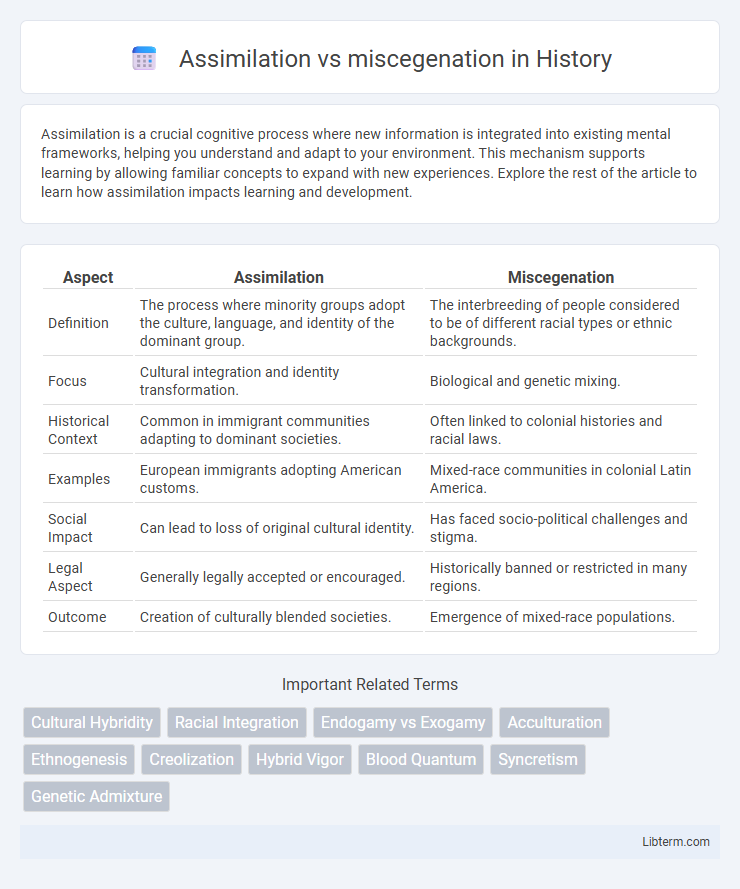Assimilation is a crucial cognitive process where new information is integrated into existing mental frameworks, helping you understand and adapt to your environment. This mechanism supports learning by allowing familiar concepts to expand with new experiences. Explore the rest of the article to learn how assimilation impacts learning and development.
Table of Comparison
| Aspect | Assimilation | Miscegenation |
|---|---|---|
| Definition | The process where minority groups adopt the culture, language, and identity of the dominant group. | The interbreeding of people considered to be of different racial types or ethnic backgrounds. |
| Focus | Cultural integration and identity transformation. | Biological and genetic mixing. |
| Historical Context | Common in immigrant communities adapting to dominant societies. | Often linked to colonial histories and racial laws. |
| Examples | European immigrants adopting American customs. | Mixed-race communities in colonial Latin America. |
| Social Impact | Can lead to loss of original cultural identity. | Has faced socio-political challenges and stigma. |
| Legal Aspect | Generally legally accepted or encouraged. | Historically banned or restricted in many regions. |
| Outcome | Creation of culturally blended societies. | Emergence of mixed-race populations. |
Understanding Assimilation: Definition and Historical Context
Assimilation refers to the process by which individuals or groups adopt the cultural traits, norms, and behaviors of another dominant society, often leading to the loss of original cultural identities. Historically, assimilation has been implemented through policies aiming to integrate minority populations into mainstream society, such as Native American boarding schools in the United States during the 19th and 20th centuries. This concept contrasts with miscegenation, which involves intermarriage and biological blending of races rather than cultural absorption.
Exploring Miscegenation: Meaning and Origins
Miscegenation refers to the interbreeding of people considered to be of different racial backgrounds, a concept historically rooted in colonial and racial classifications. The term originated in the United States during the 19th century, primarily used to describe and often stigmatize interracial marriages and relationships. Understanding miscegenation reveals societal attitudes towards race, identity, and the complexities of cultural integration over time.
Key Differences Between Assimilation and Miscegenation
Assimilation involves the process by which individuals or groups adopt the cultural traits of another group, often leading to cultural homogenization without altering biological or racial identity. Miscegenation refers to the interbreeding between individuals of different racial or ethnic backgrounds, resulting in mixed-race offspring and impacting genetic diversity. Key differences lie in assimilation's emphasis on cultural integration and identity change, whereas miscegenation centers on biological and genetic blending across racial lines.
Cultural Impacts of Assimilation
Assimilation significantly transforms cultural identities by encouraging minority groups to adopt the dominant society's language, customs, and values, often leading to the erosion of original cultural practices and traditions. This process can result in the loss of indigenous languages, traditional clothing, and unique social norms, diminishing cultural diversity within a society. Over time, assimilation impacts intergenerational transmission of heritage, as younger generations increasingly identify with mainstream culture at the expense of ancestral cultural knowledge.
Social Consequences of Miscegenation
Miscegenation, the interbreeding of people from different racial or ethnic backgrounds, has historically led to complex social consequences such as increased social stratification and racial discrimination. Communities often experienced tensions and identity conflicts, as mixed-race individuals challenged prevailing norms and faced marginalization or exclusion from both parental groups. Legal barriers and social stigmas surrounding miscegenation reinforced systemic inequalities, impacting opportunities in education, employment, and social integration.
Legal Perspectives: Assimilation vs. Miscegenation
Legal perspectives on assimilation and miscegenation reflect contrasting approaches to racial integration and identity. Assimilation laws often aimed to erase distinct ethnic identities by enforcing cultural conformity, while miscegenation laws explicitly prohibited interracial marriage and relationships to maintain racial purity. Landmark rulings such as Loving v. Virginia (1967) abolished miscegenation laws in the United States, marking a significant shift toward legal acceptance of racial integration.
Race, Identity, and Belonging in Assimilation and Miscegenation
Assimilation involves the absorption of minority groups into a dominant culture, often requiring individuals to abandon distinct racial or ethnic identities to gain social acceptance and a sense of belonging. Miscegenation, the interbreeding of different racial groups, challenges traditional racial boundaries and complicates notions of identity by producing mixed-race individuals who navigate multiple cultural heritages. Both assimilation and miscegenation impact the politics of race, reshaping identity formation and influencing societal perceptions of inclusion and exclusion.
Modern Narratives: Globalization and Evolving Concepts
Modern narratives on assimilation emphasize the blending of cultural identities into a cohesive social framework, promoting unity while preserving individual heritage. Globalization accelerates cultural exchange, challenging traditional assimilation models and highlighting the complexity of identity in diverse societies. Miscegenation, once stigmatized, is increasingly recognized as a natural outcome of interconnected populations, reshaping concepts of race and ethnicity in contemporary discourse.
Challenges and Controversies in Assimilation and Miscegenation
Assimilation often encounters challenges such as cultural erasure, identity loss, and resistance from minority communities striving to preserve their heritage. Miscegenation raises controversies related to societal acceptance, racial prejudices, and legal restrictions historically imposed on interracial relationships. Both processes reflect complex dynamics of power, social integration, and evolving definitions of identity in multicultural societies.
Future Trends: Societal Implications and Acceptance
Future trends in assimilation and miscegenation indicate growing societal acceptance of multicultural identities and mixed heritage individuals, reflecting increasing globalization and diversity. Demographic shifts and progressive social policies contribute to diminishing racial and ethnic boundaries, fostering more inclusive definitions of identity. This evolution suggests a continued move towards embracing complex cultural blends rather than strict assimilation into dominant cultures.
Assimilation Infographic

 libterm.com
libterm.com